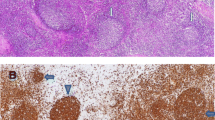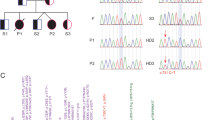Abstract
MHC class II deficiency provokes a severe immunodeficiency characterized by a lack of antigen-specific immune response. In the absence of bone marrow transplantation (the only curative treatment), patients affected by this genetic recessive disease die in early childhood. However, others and we have recently described cases of mild or asymptomatic immunodeficiencies with defects in either CIITA (class II transactivator) or RFX5, both proteins required for the transcription of HLA-D genes. We describe in this report the first case of moderate immunodeficiency resulting from a defect in RFXANK, another transcription factor essential for HLA-D expression. The patient did not display any detectable expression of MHC class II molecules on B lymphocytes, monocytes or activated T lymphocytes. Accordingly HLA-D transcription was altered in the corresponding B-lymphoblastoid cell line. The defect in RFXANK was observed both at the transcript and protein level. Indeed a homozygous IVS4+5G>A mutation was evidenced in RFXANK, and shown to hamper the splicing of intron 4. However, we had shown previously that a defect in intron 4 can lead to the skipping of exon 4, and that the resulting truncated protein retains the capacity to activate HLA-DR expression. Therefore, like the two cases of moderate immunodeficiencies described previously, we demonstrate that the RFXANK defect presented here is coherent with a residual activity of the mutant protein. We thus propose that the common feature displayed by mildly immunodeficient patients is the leakiness of the mutations, which might allow a local or temporal expression of MHC class II molecules.







Similar content being viewed by others
References
Benichou B, Strominger JL (1991) Class II-antigen-negative patient and mutant B-cell lines represent at least three, and probably four, distinct genetic defects defined by complementation analysis. Proc Natl Acad Sci USA 88:4285–4288
Benoist C, Mathis D (1990) The regulation of major histocompatibility complex class-II genes: X, Y and other letters of the alphabet. Annu Rev Immunol 8:681–715
Cresswell P (1994) Assembly, transport, and function of MHC class II molecules. Annu Rev Immunol 12:259–293
Deffrennes V, Vedrenne J, Stolzenberg MC, Piskurich J, Barbieri G, Ting JP, Charron D, Alcaide-Loridan C (2001) Constitutive expression of mhc class II genes in melanoma cell lines results from the transcription of class II transactivator abnormally initiated from its B cell-specific promoter. J Immunol 167:98–106
DeSandro AM, Nagarajan UM, Boss JM (2000) Associations and interactions between bare lymphocyte syndrome factors. Mol Cell Biol 20:6587–6599
Dorn A, Bollekens J, Staub A, Benoist C, Mathis D (1987) A multiplicity of CCAAT box-binding proteins. Cell 50:863–872
Durand B, Kobr M, Reith W, Mach B (1994) Functional complementation of major histocompatibility complex class II regulatory mutants by the purified X-box-binding protein RFX. Mol Cell Biol 14:6839–6847
Durand B, Sperisen P, Emery P, Barras E, Zufferey M, Mach B, Reith W (1997) RFXAP, a novel subunit of the RFX DNA binding complex is mutated in MHC class II deficiency. EMBO J 16:1045–1055
Fontes JD, Jiang B, Peterlin BM (1997) The class II trans-activator CIITA interacts with the TBP-associated factor TAFII32. Nucleic Acids Res 25:2522–2528
Glimcher LH, Kara CJ (1992) Sequences and factors: a guide to MHC class II transcription. Annu Rev Immunol 10:13–50
Harton JA, O’Connor W, Conti BJ, Linhoff MW, Ting JP (2002) Leucine-rich repeats of the class II transactivator control its rate of nuclear accumulation. Hum Immunol 63:588–601
Hauber I, Gulle H, Wolf HM, Maris M, Eggenbauer H, Eibl MM (1995) Molecular characterization of major histocompatibility complex class II gene expression and demonstration of antigen-specific T cell response indicate a new phenotype in class II-deficient patients. J Exp Med 181:1411–1423
Hirschhorn R, Yang DR, Israni A, Huie ML, Ownby DR (1994) Somatic mosaicism for a newly identified splice-site mutation in a patient with adenosine deaminase-deficient immunodeficiency and spontaneous clinical recovery. Am J Hum Genet 55:59–68
Hume CR, Lee JS (1989) Congenital immunodeficiencies associated with absence of HLA class II antigens on lymphocytes results from distinct mutations in trans-acting factors. Human Immunol 26:288–309
Klein C, Lisowska-Grospierre B, LeDeist F, Fischer A, Griscelli C (1993) Major histocompatibility complex class II deficiency: clinical manifestations, immunologic features, and outcome. J Pediatr 123:921–929
Klein C, Cavazzana-Calvo M, Le Deist F, Jabado N, Benkerrou N, Blanche S, Lisowska-Grospierre B, Griscelli C, Fischer A (1995) Bone marrow transplantation in major histocompatibility complex class II deficiency: a single-center study of 19 patients. Blood 85:580–587
Kretsovali A, Agalioti T, Spilianakis C, Tzortzakaki E, Merika M, Papamatheakis J (1998) Involvement of CREB binding protein in expression of major histocompatibility complex class II genes via interaction with the class II transactivator. Mol Cell Biol 18:6777–6783
Le Deist F, Thoenes G, Corado J, Lisowska-Grospierre B, Fischer A (1991) Immunodeficiency with low expression of the T cell receptor/CD3 complex. Effect on T lymphocyte activation. Eur J Immunol 21:1641–1647
Lennon-Duménil AM, Barbouche MR, Vedrenne J, Prod’homme T, Ghariani S, Béjaoui M, Charron D, Fellous M, Dellagi K, Alcaïde-Loridan C (2001) Uncoordinated HLA-D gene expression in a RFXANK-defective patient with MHC class II deficiency. J Immunol 166:5681–5687
Lisowska-Grospierre B, Charron DJ, de Préval C, Durandy A, Griscelli C, Mach B (1985) A defect in the regulation of major histocompatibility complex class II gene expression in human HLA-DR negative lymphocytes from patients with a combined immunodeficiency syndrome. J Clin Invest 76:381–385
Lisowska-Grospierre B, Fondaneche M-C, Rois M-P, Griscelli C, Fischer A (1994) Two complementation groups account for most cases in inherited MHC class II deficiency. Hum Mol Genet 3:953–958
Masternak K, Barras E, Zufferey M, Conrad B, Corthals G, Aebersold R, Sanchez JC, Hochstrasser DF, Mach B, Reith W (1998) A gene encoding a novel RFX-associated transactivator is mutated in the majority of MHC class II deficiency patients. Nat Genet 20:273–277
Moreno CS, Beresford GW, Louis-Plence P, Morris AC, Boss JM (1999) CREB regulates MHC class II expression in a CIITA-dependent manner. Immunity 10:143–151
Nagarajan UM, Louis-Plence P, DeSandro A, Nilsen R, Bushey A, Boss JM (1999) RFX-B is the gene responsible for the most common cause of the bare lymphocyte syndrome, an MHC class II deficiency. Immunity 10:153–162
Nagarajan UM, Peijnenburg A, Gobin SJ, Boss JM, van Den Elsen PJ (2000) Novel mutations within the RFX-B gene and partial rescue of MHC and related genes through exogenous class II transactivator in RFX-B-deficient cells. J Immunol 164:3666–3674
Nekrep N, Jabrane-Ferrat N, Peterlin BM (2000) Mutations in the bare lymphocyte syndrome define critical steps in the assembly of the regulatory factor X complex. Mol Cell Biol 20:4455–4461
Nekrep N, Geyer M, Jabrane-Ferrat N, Peterlin BM (2001) Analysis of ankyrin repeats reveals how a single point mutation in RFXANK results in bare lymphocyte syndrome. Mol Cell Biol 21:5566–5576
Nekrep N, Jabrane-Ferrat N, Wolf HM, Eibl MM, Geyer M, Peterlin BM (2002) Mutation in a winged-helix DNA-binding motif causes atypical bare lymphocyte syndrome. Nat Immunol 3:1075–1081
Nicholls AC, Oliver J, McCarron S, Winter GB, Pope FM (1996) Splice site mutation causing deletion of exon 21 sequences from the pro alpha 2(I) chain of type I collagen in a patient with severe dentinogenesis imperfecta but very mild osteogenesis imperfecta. Hum Mutat 7:219–227
Ozsahin H, Arredondo-Vega FX, Santisteban I, Fuhrer H, Tuchschmid P, Jochum W, Aguzzi A, Lederman HM, Fleischman A, Winkelstein JA, Seger RA, Hershfield MS (1997) Adenosine deaminase deficiency in adults. Blood 89:2849–2855
Quan V, Towey M, Sacks S, Kelly AP (1999) Absence of MHC class II gene expression in a patient with a single amino acid substitution in the class II transactivator protein CIITA. Immunogenetics 49:957–963
Reith W, Muhlethaler-Mottet A, Masternak K, Villard J, Mach B (1999) The molecular basis of MHC class II deficiency and transcriptional control of MHC class II gene expression. Microbes Infect 1:839–846
Santisteban I, Arredondo-Vega FX, Kelly S, Mary A, Fischer A, Hummell DS, Lawton A, Sorensen RU, Stiehm ER, Uribe L, et al. (1993) Novel splicing, missense, and deletion mutations in seven adenosine deaminase-deficient patients with late/delayed onset of combined immunodeficiency disease. Contribution of genotype to phenotype. J Clin Invest 92:2291–2302
Steimle V, Otten LA, Zufferey M, Mach B (1993) Complementation cloning of an MHC class II transactivator mutated in hereditary MHC class II deficiency (or bare lymphocyte syndrome). Cell 75:135–146
Steimle V, Siegrist CA, Mottet A, Lisowska-Grospierre B, Mach B (1994) Regulation of MHC class II expression by interferon-gamma mediated by the transactivator gene CIITA. Science 265:106–109
Steimle V, Durand B, Barras E, Zufferey M, Hadam MR, Mach B, Reith W (1995) A novel DNA-binding regulatory factor is mutated in primary MHC class II deficiency (bare lymphocyte syndrome). Genes Dev 9:1021–1032
Towey M, Kelly AP (2002) Nuclear localisation of CIITA is controlled by a carboxy terminal leucine-rich repeat region. Mol Immunol 38:627–634
Watson AJ, DeMars R, Trowbridge IS, Bach FH (1983) Detection of a novel human class II HLA antigen. Nature 304:358–361
Wiszniewski W, Fondaneche MC, Lambert N, Masternak K, Picard C, Notarangelo L, Schwartz K, Bal J, Reith W, Alcaïde C, de Saint Basile G, Fischer A, Lisowska-Grospierre B (2000) Founder effect for a 26-bp deletion in the RFXANK gene in North African MHC class II deficient patients belonging to complementation group B. Immunogenetics 51:261–267
Wiszniewski W, Fondaneche MC, Le Deist F, Kanariou M, Selz F, Brousse N, Steimle V, Barbieri G, Alcaide-Loridan C, Charron D, Fischer A, Lisowska-Grospierre B (2001) Mutation in the class II trans-activator leading to a mild immunodeficiency. J Immunol 167:1787–1794
Wiszniewski W, Fondaneche MC, Louise-Plence P, Prochnicka-Chalufour A, Selz F, Picard C, Le Deist F, Eliaou JF, Fischer A, Lisowska-Grospierre B (2003) Novel mutations in the RFXANK gene: RFX complex containing in-vitro-generated RFXANK mutant binds the promoter without transactivating MHC II. Immunogenetics 54:747–755
Wolf HM, Hauber I, Gulle H, Thon V, Eggenbauer H, Fischer MB, Fiala S, Eibl MM (1995) Twin boys with major histocompatibility complex class II deficiency but inducible immune responses. N Engl J Med 332:86–90
Zhu XS, Linhoff MW, Li G, Chin KC, Maity SN, Ting JP (2000) Transcriptional scaffold: CIITA interacts with NF-Y, RFX, and CREB To cause stereospecific regulation of the class II major histocompatibility complex promoter. Mol Cell Biol 20:6051–6061
Acknowledgements
We wish to thank Marie-Claude Fondanèche (INSERM U429) for the establishment of the SM B-LCL. This work has been supported in part by a grant from INSERM Progrès. T.P. was the recipient of a MENRT fellowship. G.B. was the recipient of fellowships from the INSERM (Poste Vert), then from the Fondation pour la Recherche Médicale.
Author information
Authors and Affiliations
Corresponding author
Additional information
The senior co-authors, C. Alcaide-Loridan and S. Pollack, have participated equally in this publication
Rights and permissions
About this article
Cite this article
Prod’homme, T., Dekel, B., Barbieri, G. et al. Splicing defect in RFXANK results in a moderate combined immunodeficiency and long-duration clinical course. Immunogenetics 55, 530–539 (2003). https://doi.org/10.1007/s00251-003-0609-2
Received:
Revised:
Published:
Issue Date:
DOI: https://doi.org/10.1007/s00251-003-0609-2




